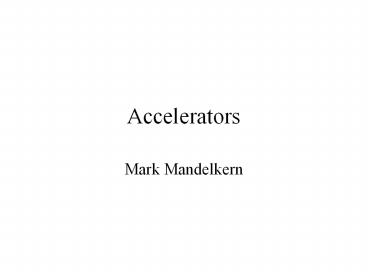Accelerators - PowerPoint PPT Presentation
Title:
Accelerators
Description:
Accelerators Mark Mandelkern For producing beams of energetic particles Protons, antiprotons and light ions heavy ions electrons and positrons (secondary) neutral ... – PowerPoint PPT presentation
Number of Views:75
Avg rating:3.0/5.0
Title: Accelerators
1
Accelerators
- Mark Mandelkern
2
For producing beams of energetic particles
- Protons, antiprotons and light ions
- heavy ions
- electrons and positrons
- (secondary) neutral beams (photons, neutrons,
neutrinos)
3
Some accelerator applications
- particle and nuclear physics
- synchrotron radiation
- materials science, biology
- medical radiation therapy
- isotope production
- plasma heating
- high energy X-ray production
- non-destructive testing, food sterilization
4
Accelerators in particle physics
- probe small-scale structure
- l h/p197 10-13 cm /p(MeV/c)
- electrons, positrons
- Pointlike (also neutrinos), no strong
interactions - costly to accelerate (synchrotron radiation)
- protons and antiprotons
- complicated structures make interpretation
difficult - easier to accelerate to ultra-high energies
5
Accelerator types
- electrostatic
- battery, lightning, van de Graff, Pellatron to
about 30 MeV for nuclear physics and isotope
production - cascade
- Cockcroft-Walton to several MeV cheap for
X-ray sources and injectors - Linear
- RFQ
- drift-tube(Wideroe, Alvarez)preaccelerators,
LAMPF - Waveguideelectrons only(SLAC, NLC)
6
Pelletron
7
Van de Graff
8
Cockcroft-Walton principle
9
ISIS Cockcroft-Walton
10
Wideroe Linac
11
Alvarez Linac
12
Radiofrequency Quadrupole RFQ
13
SLAC Linac
14
SLAC Waveguide
15
Phase Stability
16
Circular Accelerators
- betatron
- electrons only, cheap, portable, to 500 MeV
- cyclotron
- Protons to 500 MeV (TRIUMF, PSI)
- Synchrotron
- 100 GeV electrons (LEP)
- 1 TeV protons and antiprotons (FNAL)
- 7 TeV protons (LHC)
17
Cyclotron animation
18
First cyclotron
19
TRIUMF
20
Strong focusing principle
21
Strong focusing animation
22
HEP Accelerator Systems
- FNAL Tevatron(1 TeV p)
- CW(750 keV)LinacBooster(8 GeV)Main
Injector(120 GeV) Tevatron Ring - CERN SPS/LEP(400 GeV p/100 GeV e-)
- RFQ (750 keV)Linac (50 MeV)PS(28 GeV)SPSLEP
23
FNAL Tevatron Tunnel
24
Synchrotron radiation
- W(e2/3e0)(g4b3/R) loss per turn
- Ec(hc/2p)(3g3/2R) peak energy
- gE/mc2
- LEP 100 GeV/beam R4.9km W3 GeV Ec 90
keV(hard X-ray) 288 SC RF cavities - Tevatron E1 TeV R1.1km W 10 eV Ec0.4 eV
- LHC E7 TeV R4.9 kmW5 keV, Ec27 eV
25
Colliders
- Circular
- e- e below 10 GeV (BEPS/PEP-2/KEKB)
- 1 TeV p/1 TeV pbar (Tevatron-FNAL),
- 27.5 GeV e-/920 GeV p (HERA-DESY)
- 105 GeV e-/105 GeV e (LEP-CERN)
- 7 TeV p/7TeV p (LHC-CERN)
- Linear
- 50 GeV e-/50 GeV e (SLC-SLAC)
- 1 TeV e-/1 TeV e (NLC-?)
26
Why Colliders?
- Fixed target (pp)
- Ecm2mb2mt22Ebmt
- Eb1 TeV mbmt0.938 GeV Ecm43.3 GeV
- Symmetrical Collider
- EcmEbEt
- EbEt 1 TeV Ecm2 TeV
27
How Colliders?
- Event Rate Ls
- Lf n1n2/(4psxsy)
- n1 n2 particles per bunch
- sx,sy rms horizontal (vertical) beam profile
- Thus intense bunched beams with tiny beam spots
at the interaction points
28
LEP
29
LHC
30
SLC/NLC































